Abstract
Selective adrenoceptor agonists and antagonists have been used to analyse the effects of stimulation of individual types of adrenoceptor in various parts of the rabbit heart. The selective alpha 1- and alpha 2-adrenoceptor agonists used were St 587 and BHT 933 respectively, and the antagonists were prazosin (alpha 1) and WY 25309 (alpha 2). The selective beta 1- and beta 2-adrenoceptor antagonists were atenolol and ICI 118551, respectively. Pirbuterol was a highly selective beta 2-adrenoceptor agonist. The non-selective agonists noradrenaline, adrenaline and isoprenaline were also employed with various combinations of antagonists. Phenylephrine was found to stimulate beta- as well as alpha-adrenoceptors. Rimiterol was a beta-adrenoceptor agonist, partially selective for beta 2-adrenoceptors. In the sinus node beta 1-, but not beta 2-adrenoceptor stimulation increased the fast phase of depolarization (Vmax). Both beta 1- and beta 2-adrenoceptor stimulation increased the slope of slow diastolic depolarization, accelerated repolarization and increased maximum diastolic potential. After blockade of both beta 1- and beta 2-adrenoceptors alpha 1-adrenoceptor stimulation caused bradycardia, due exclusively to delayed repolarization. alpha 2-adrenoceptor stimulation had no effect. In Purkinje cells and papillary muscle both beta 1- and beta 2-adrenoceptor stimulation accelerated repolarization. Stimulation of alpha 2-adrenoceptors had no effect. Beta 1-, not beta 2-adrenoceptor stimulation augmented peak contractions 3-5-fold, and greatly increased rate of development of tension. After beta-blockade alpha 1-adrenoceptor stimulation moderately increased peak contractions (up to 47%), but increased time-to-peak and duration of contractions. These patterns of adrenoceptor-mediated effects were unchanged in animals pre-treated with sufficient 6-hydroxydopamine to eliminate responses to sympathetic nerve stimulation. The results would be consistent with beta 1-, and beta 2-adrenoceptor stimulation increasing inward calcium current, and with stimulation of alpha 1-adrenoceptors delaying its inactivation, rather than increasing its magnitude.
Full text
PDF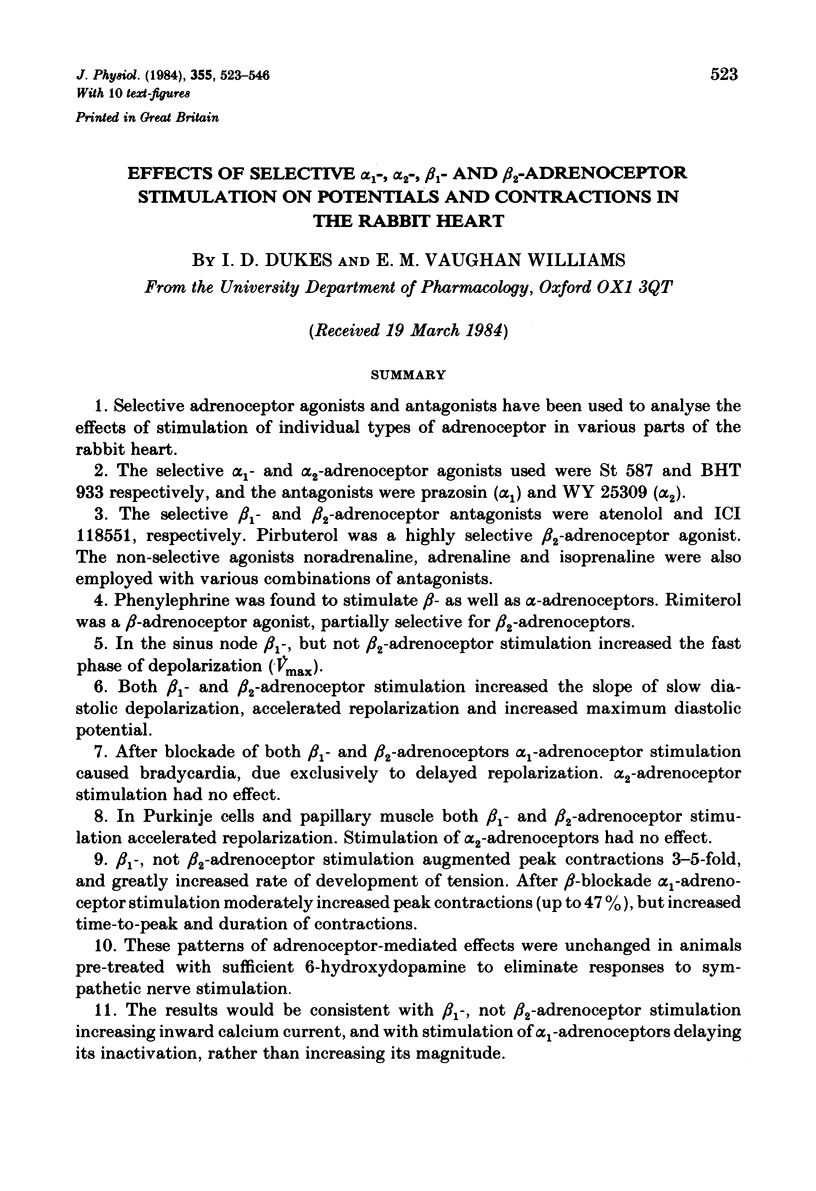
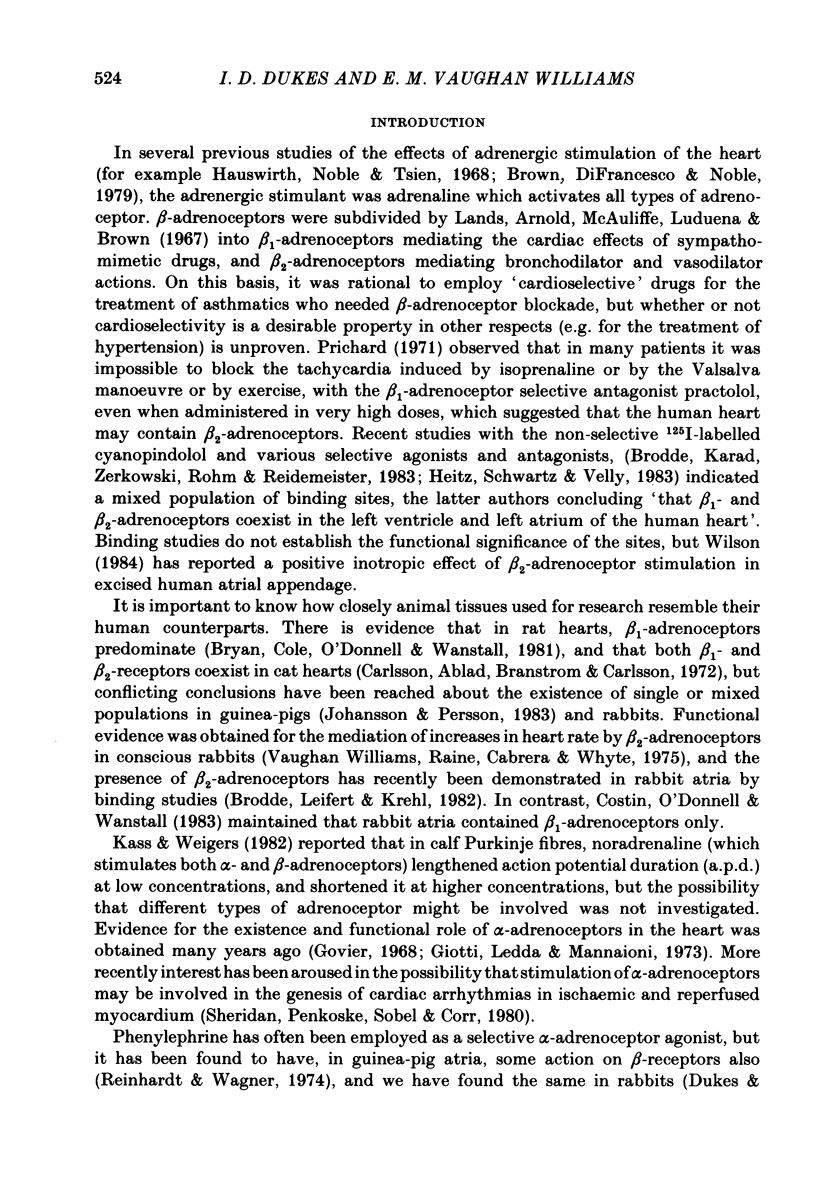
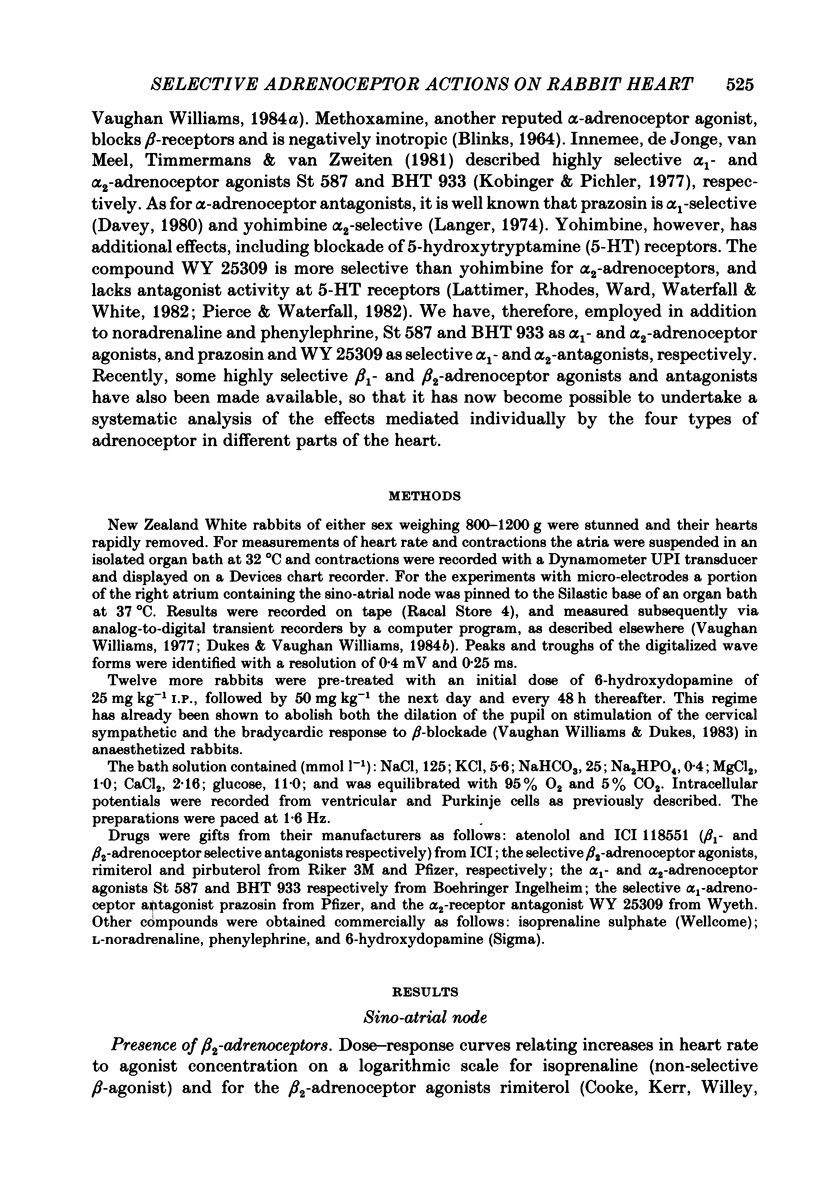
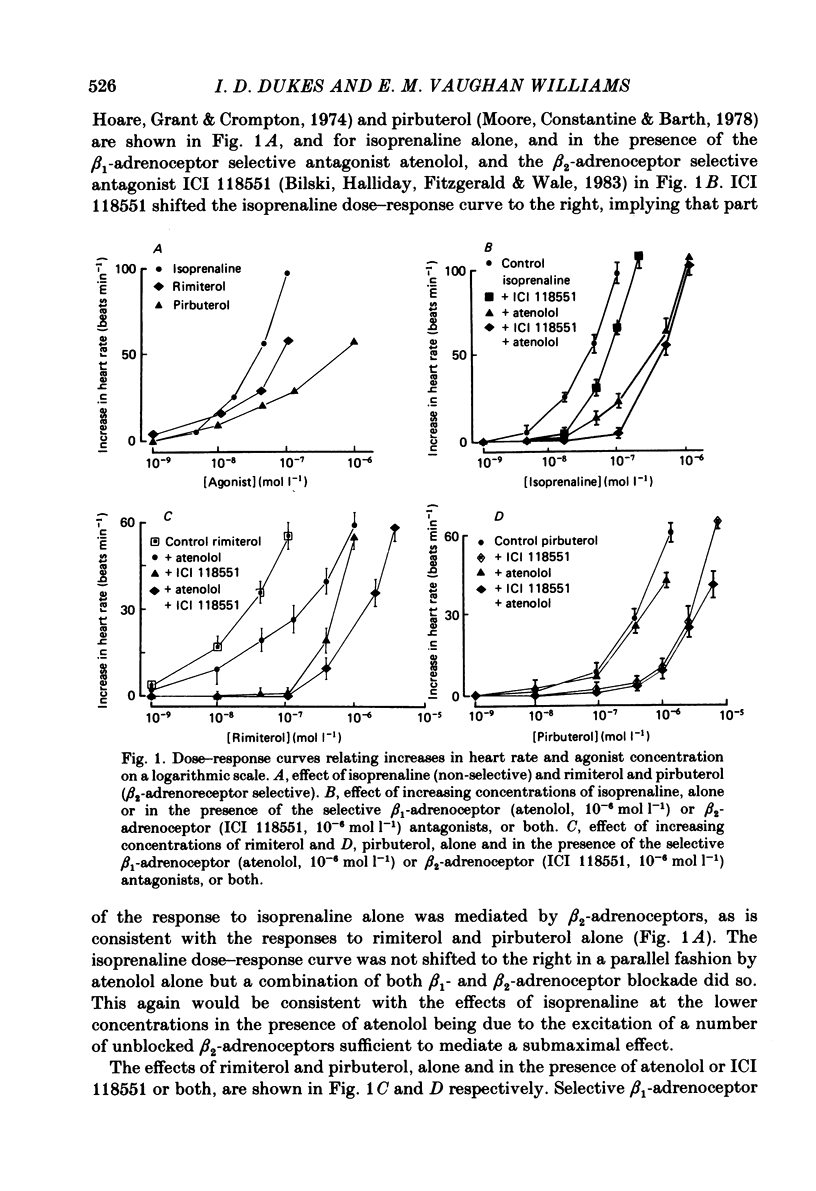
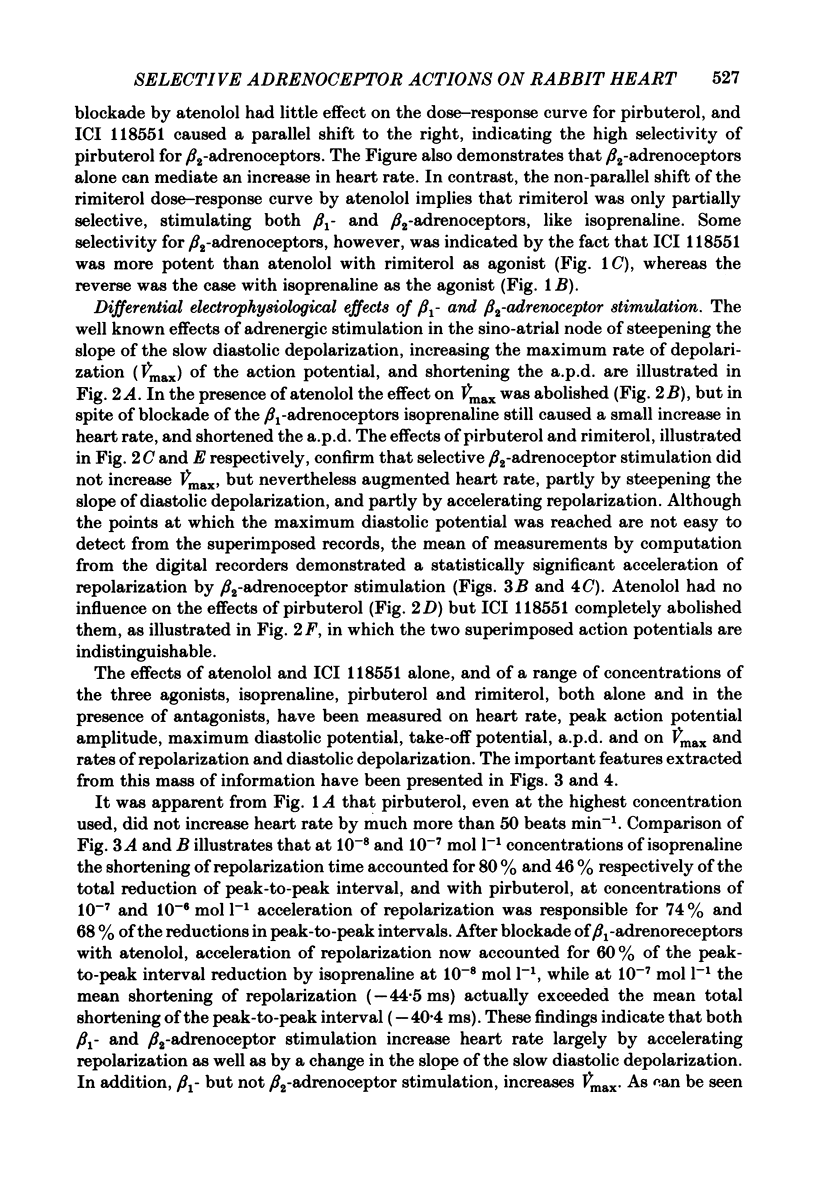
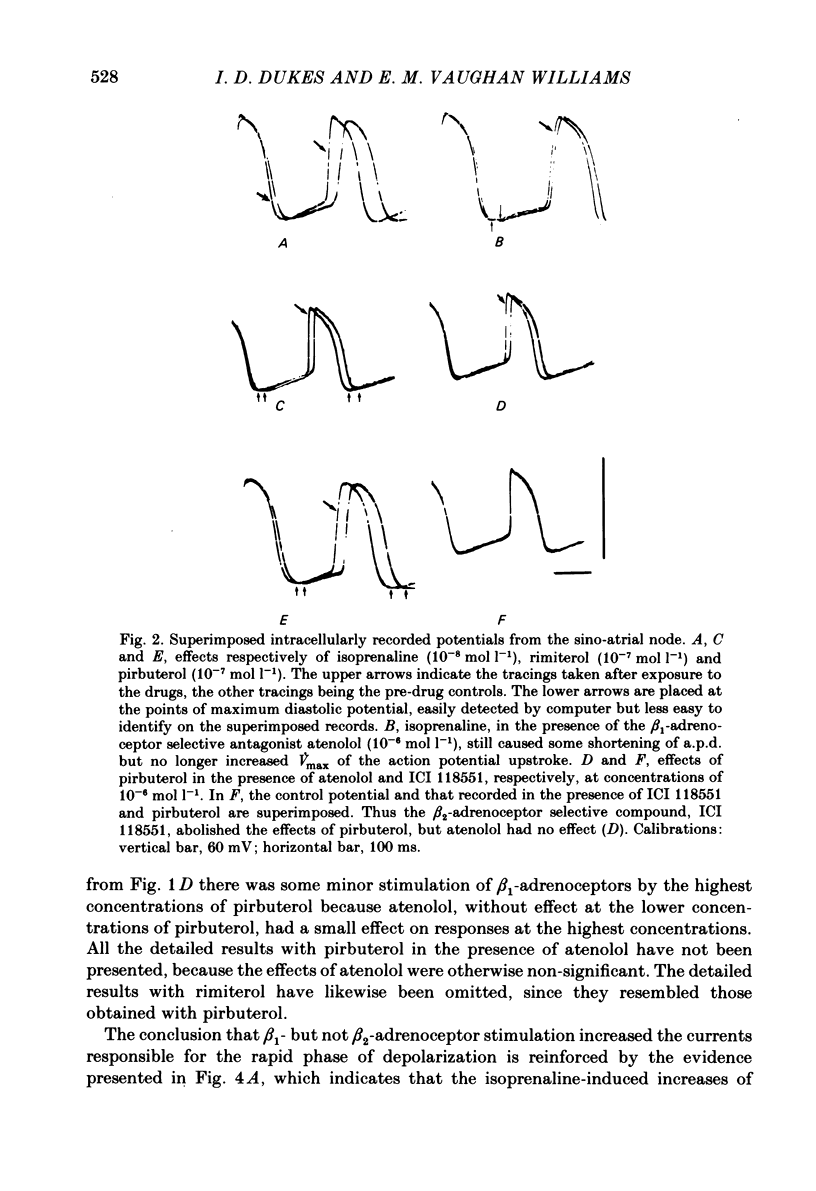
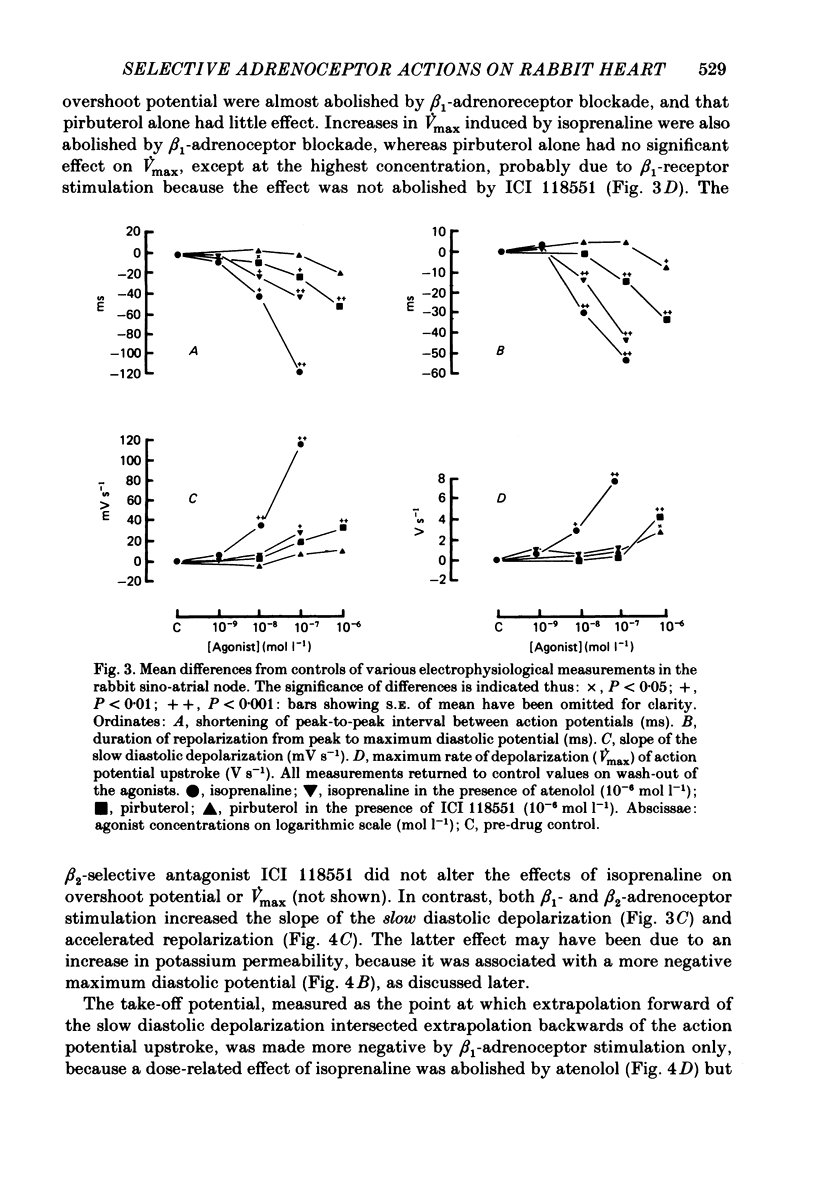
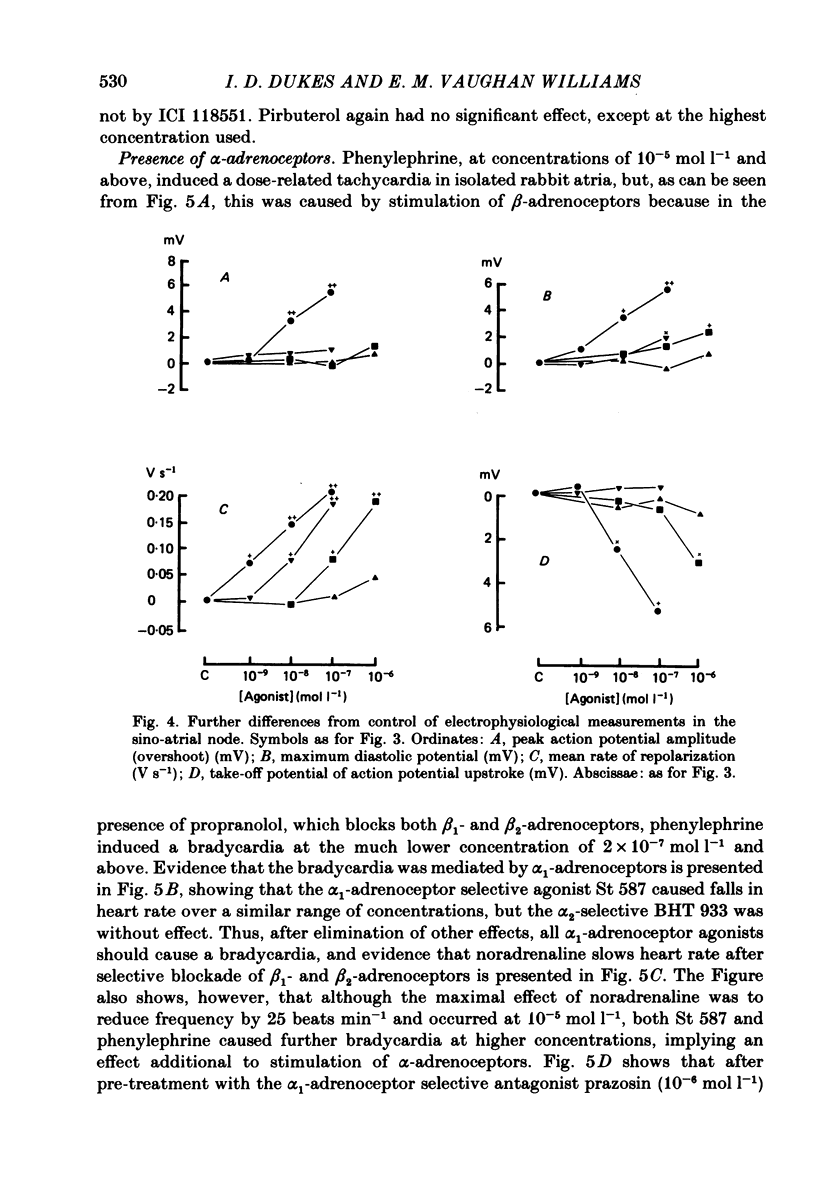
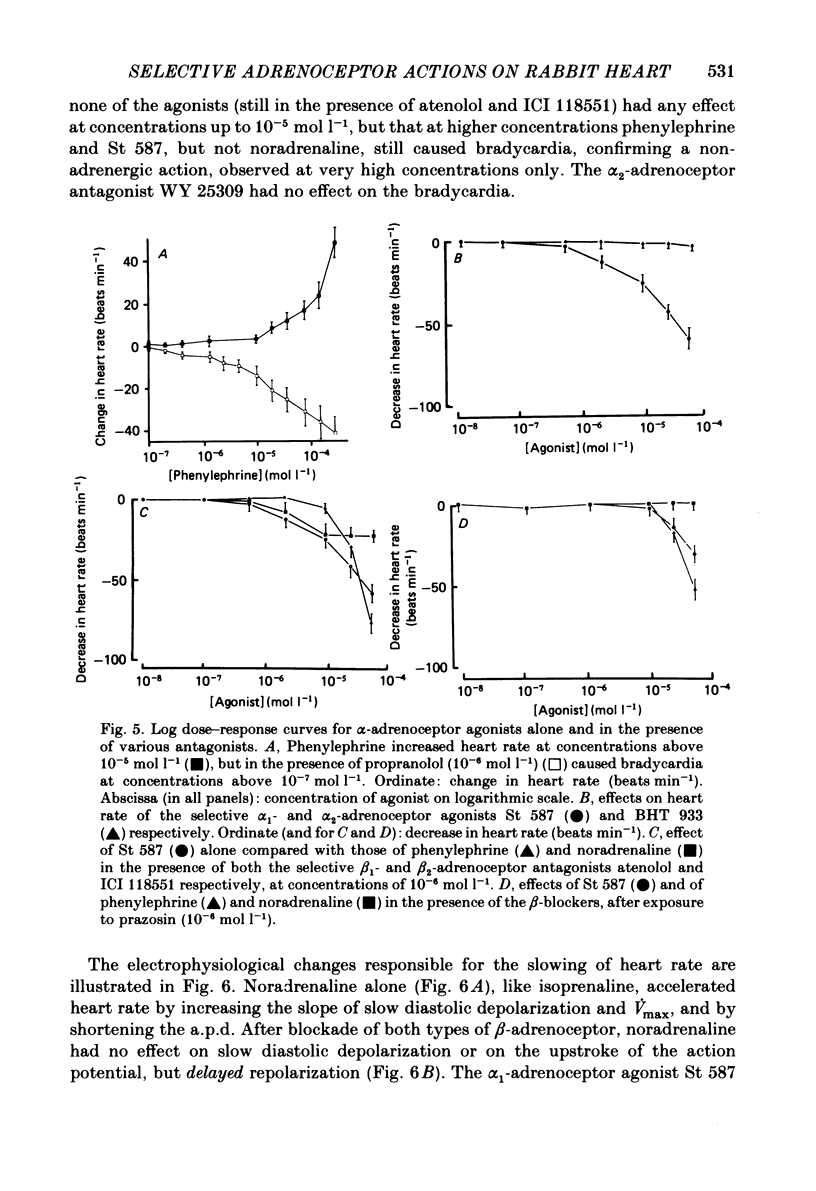
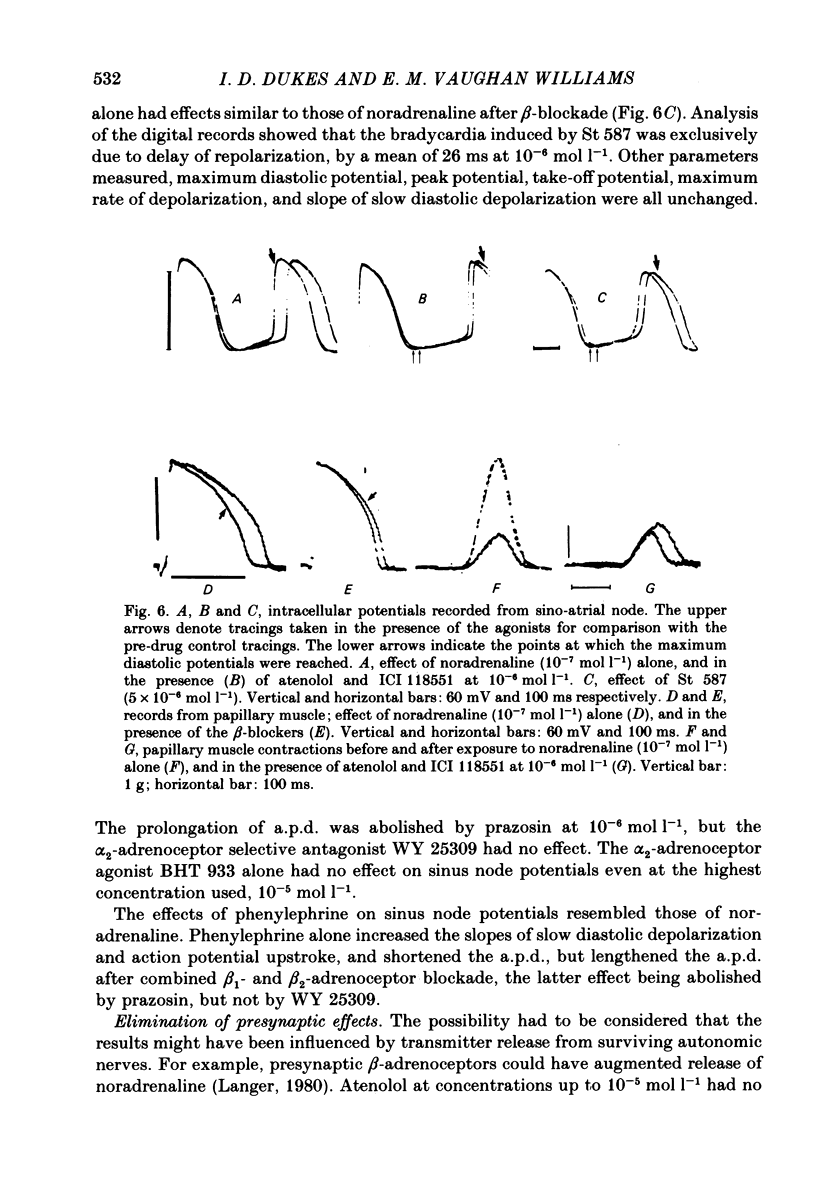
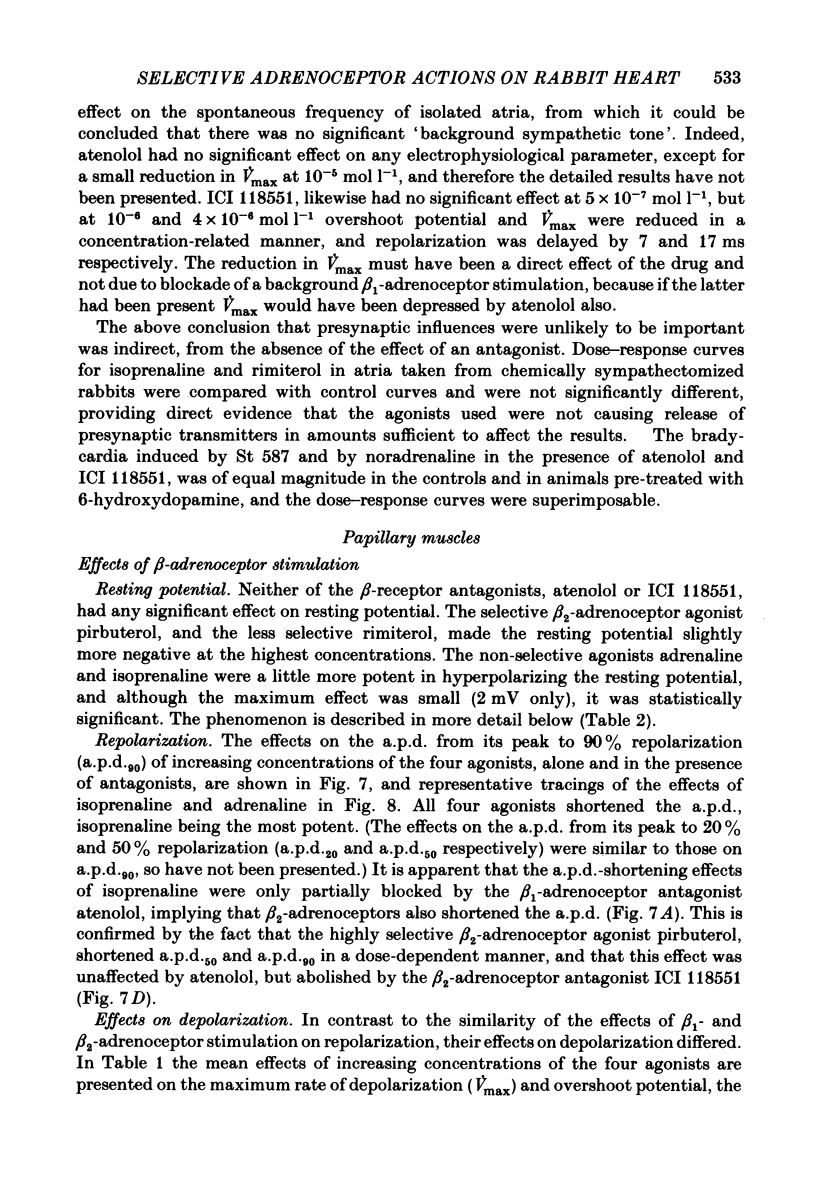
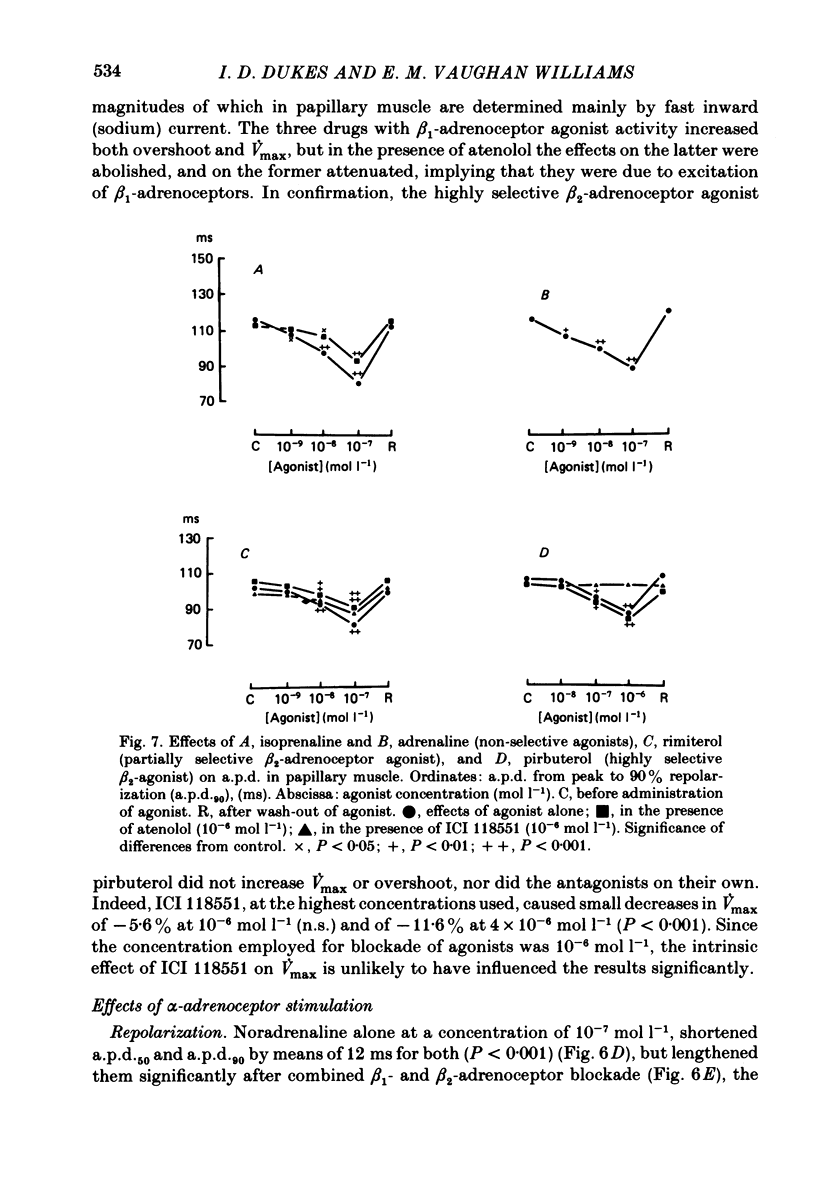
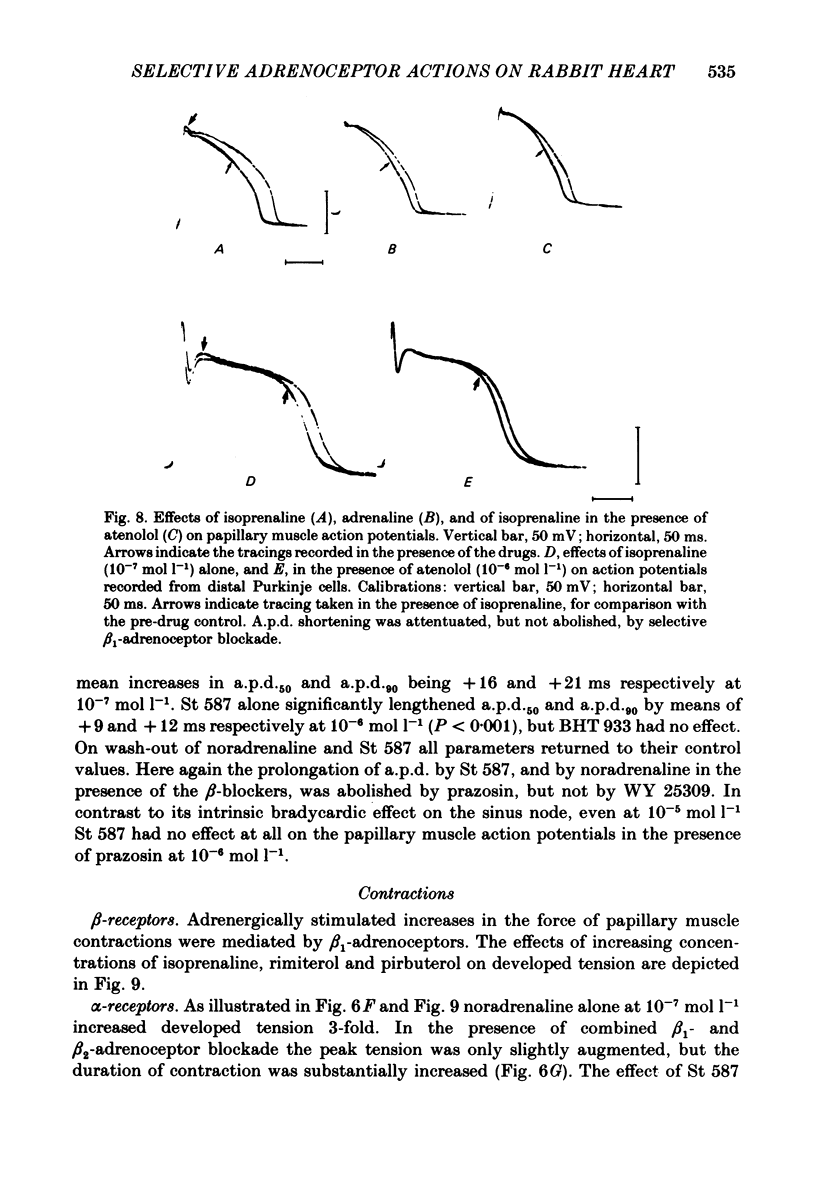
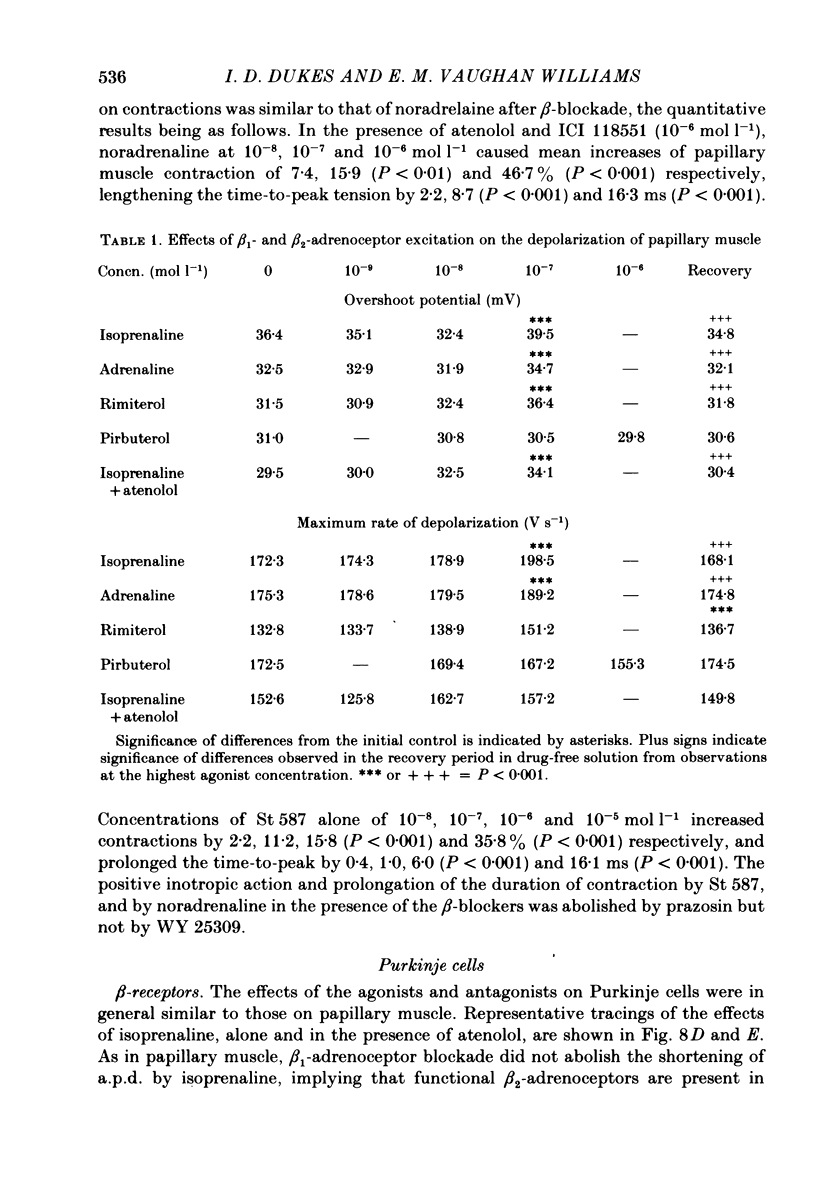
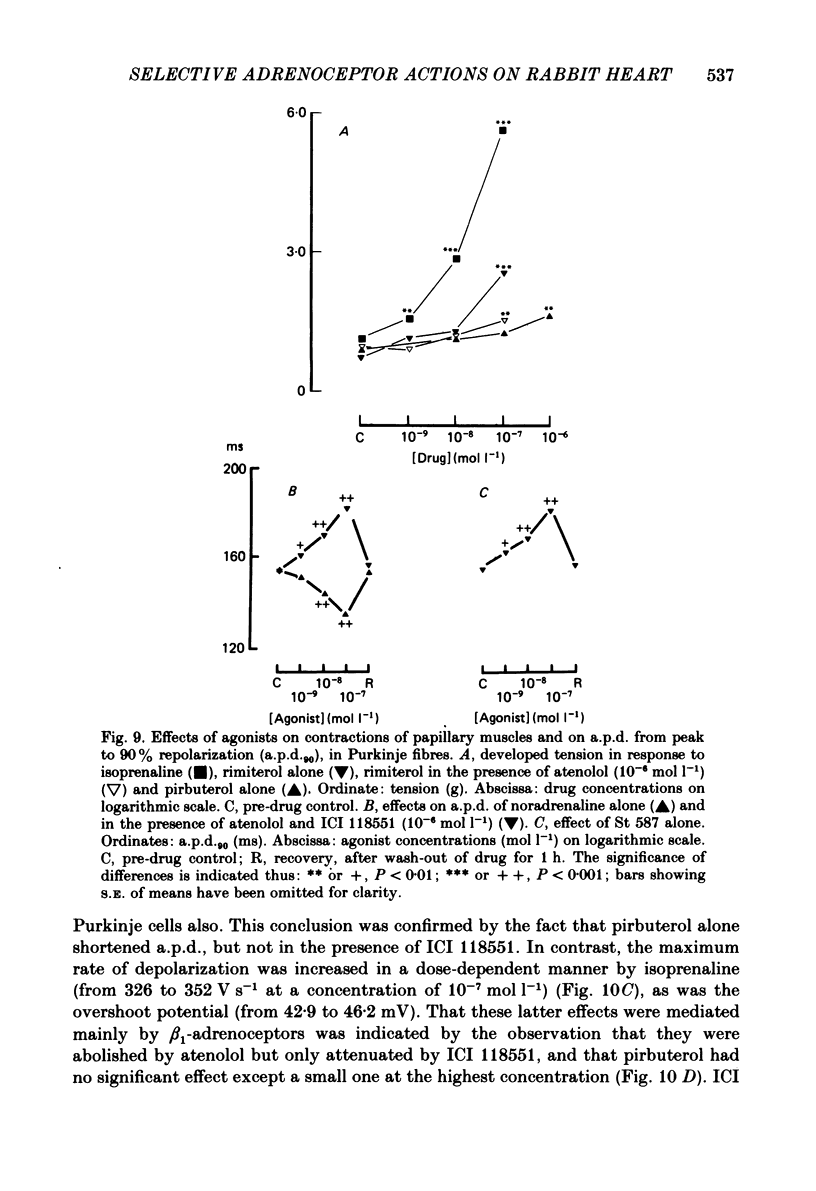

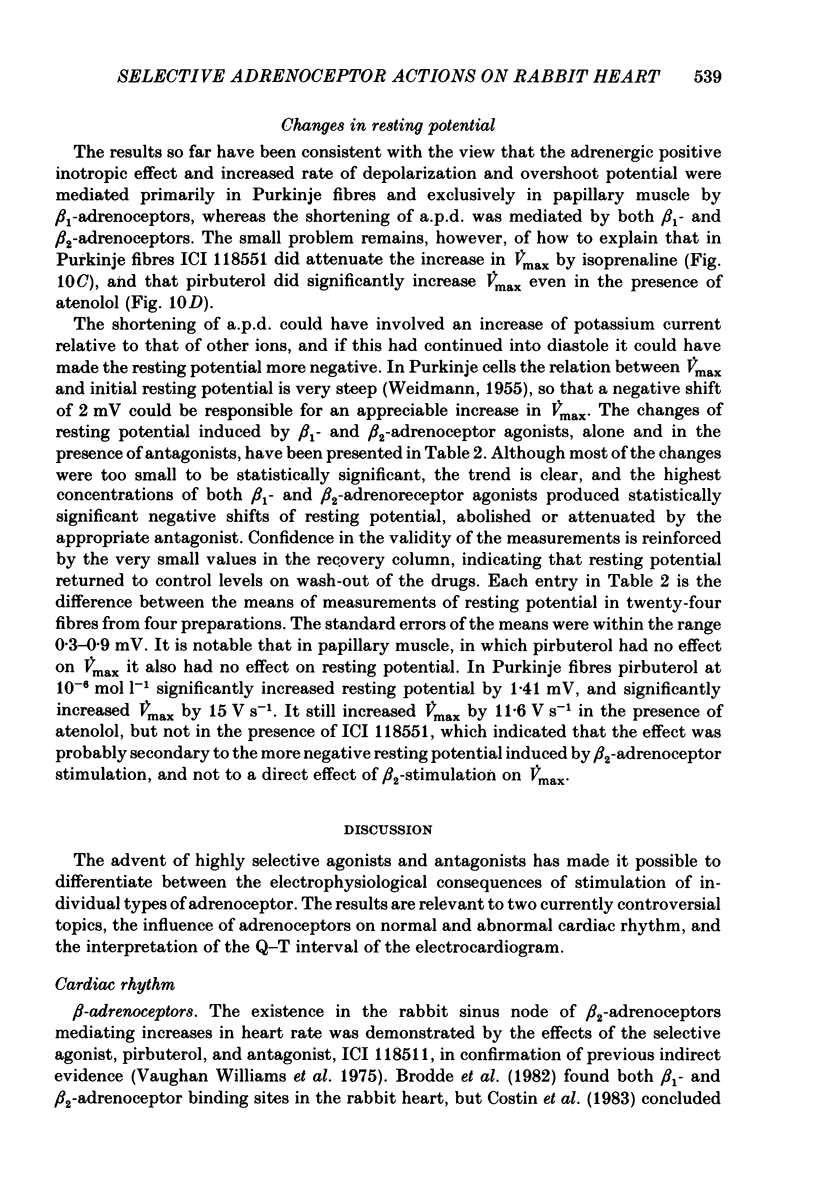
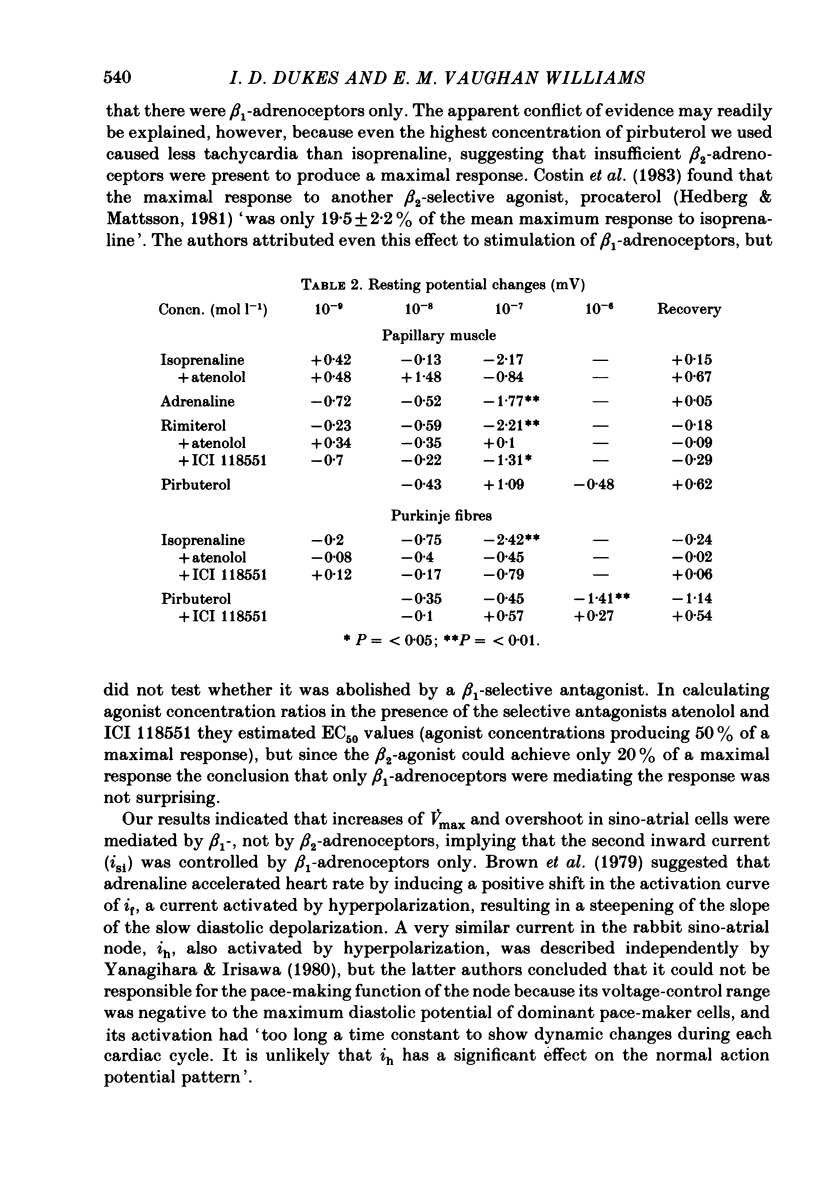
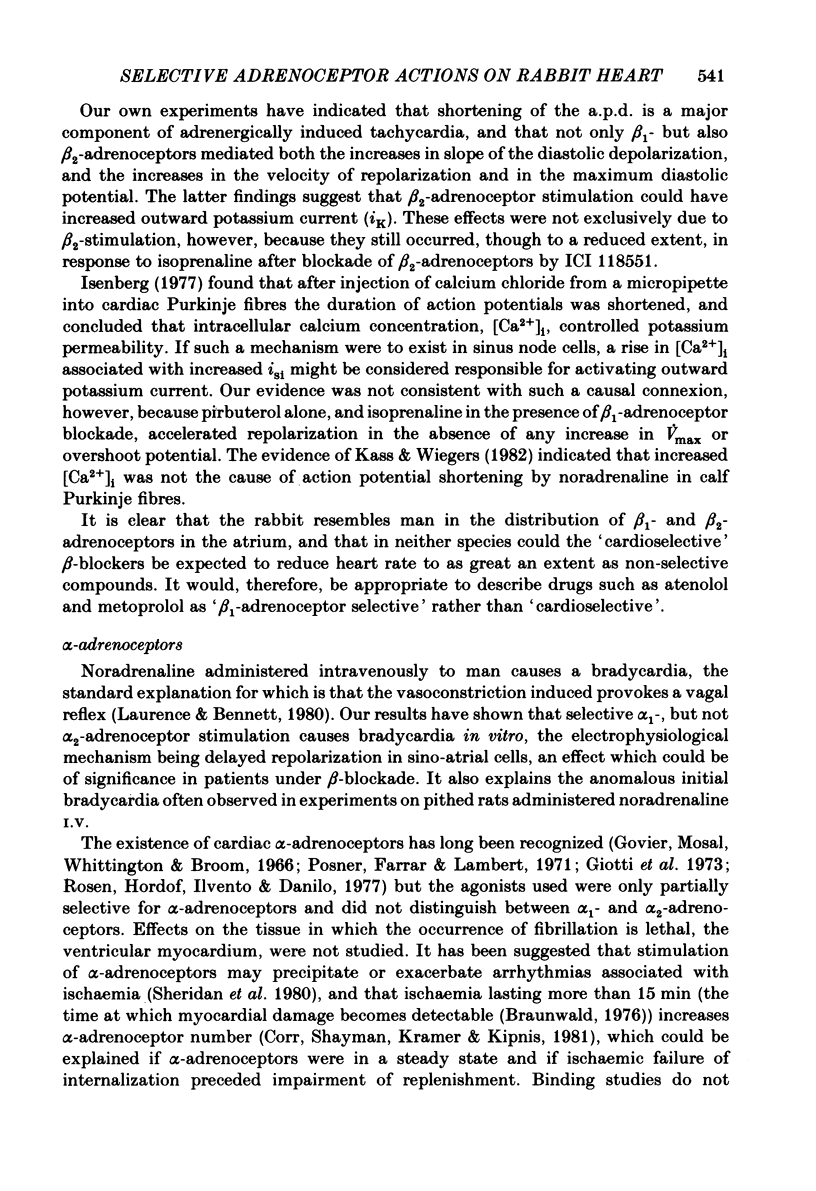
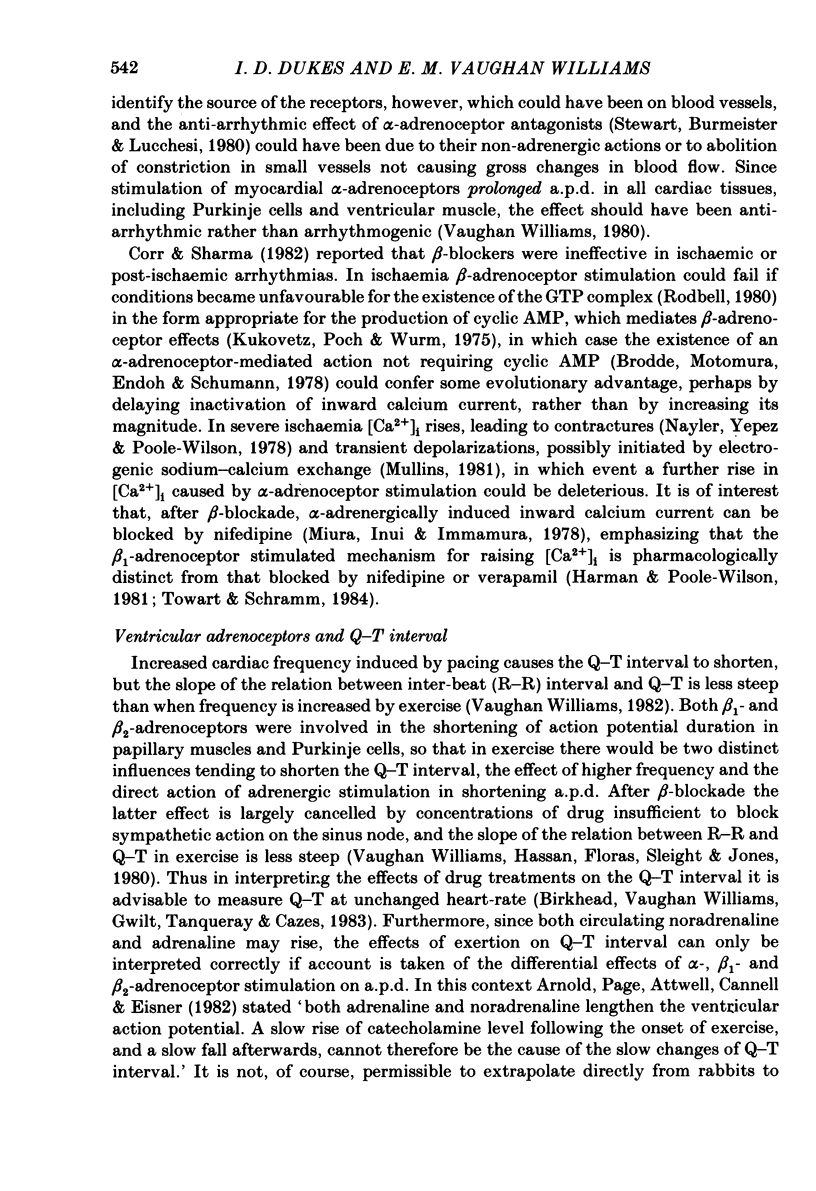
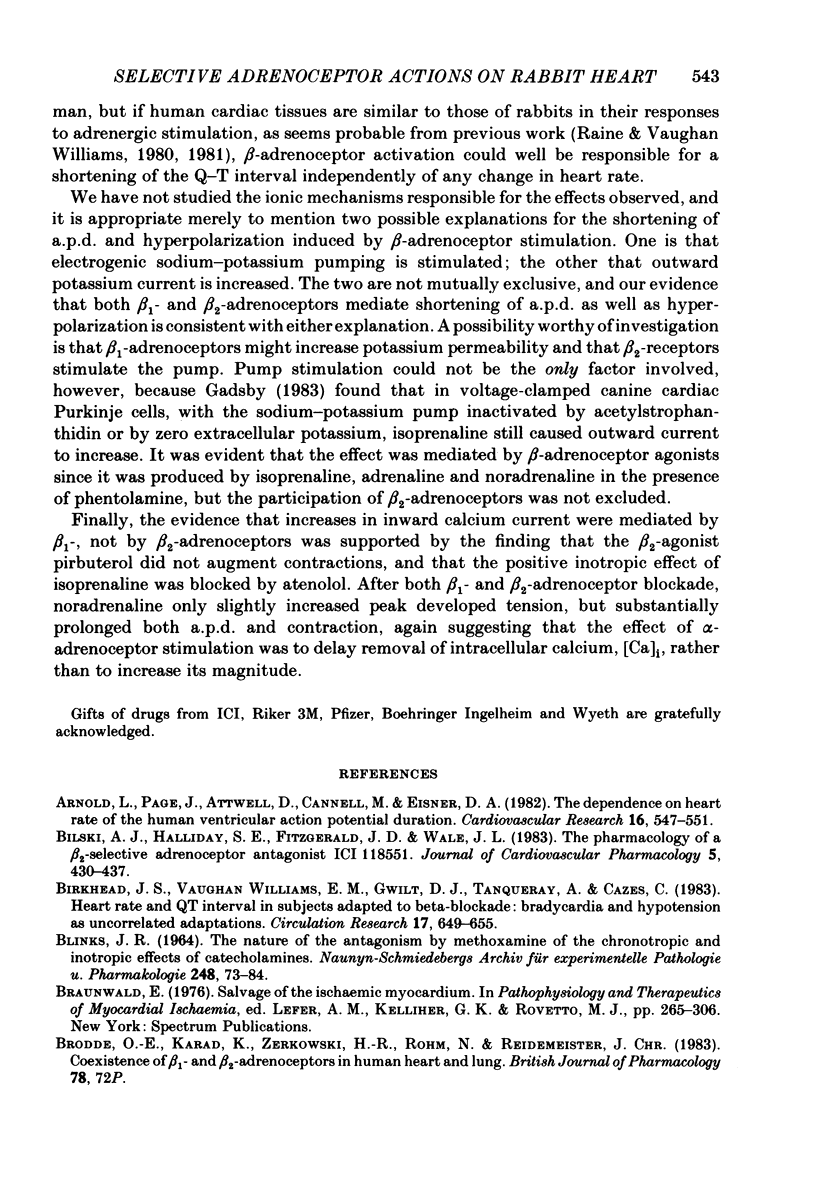
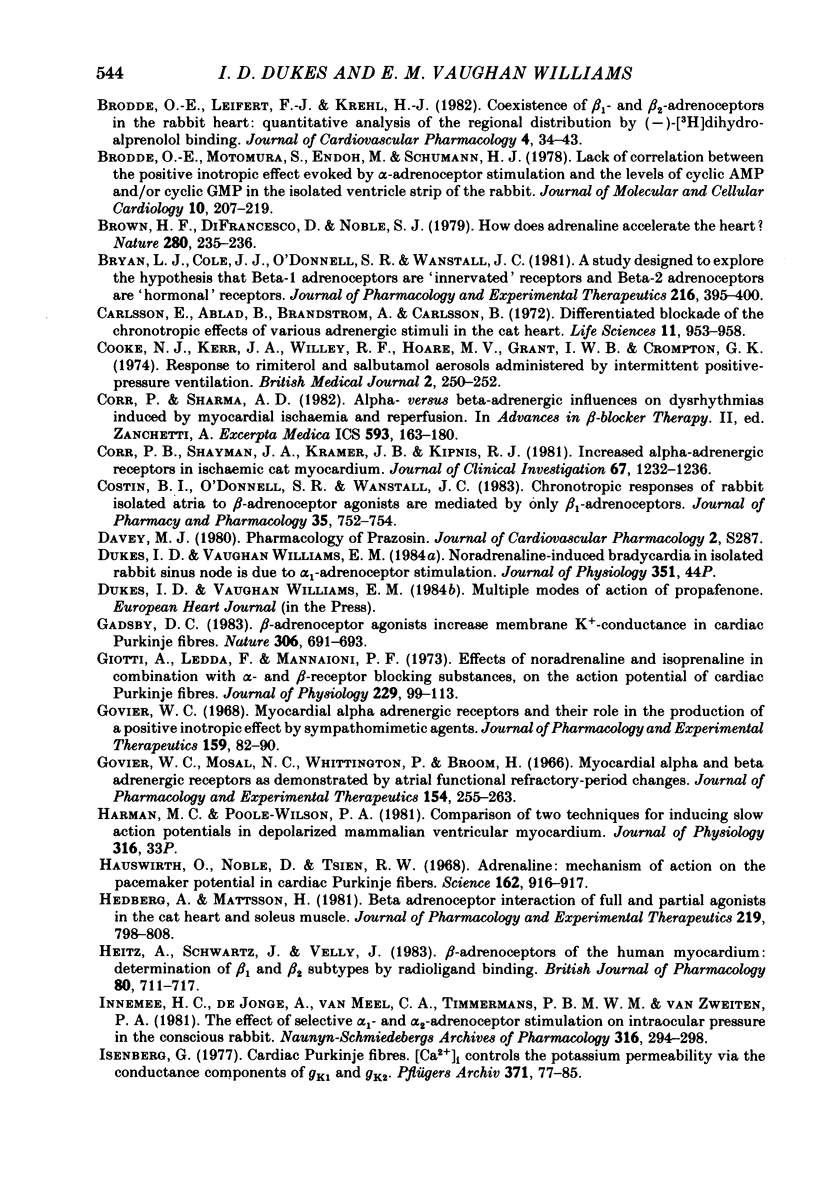
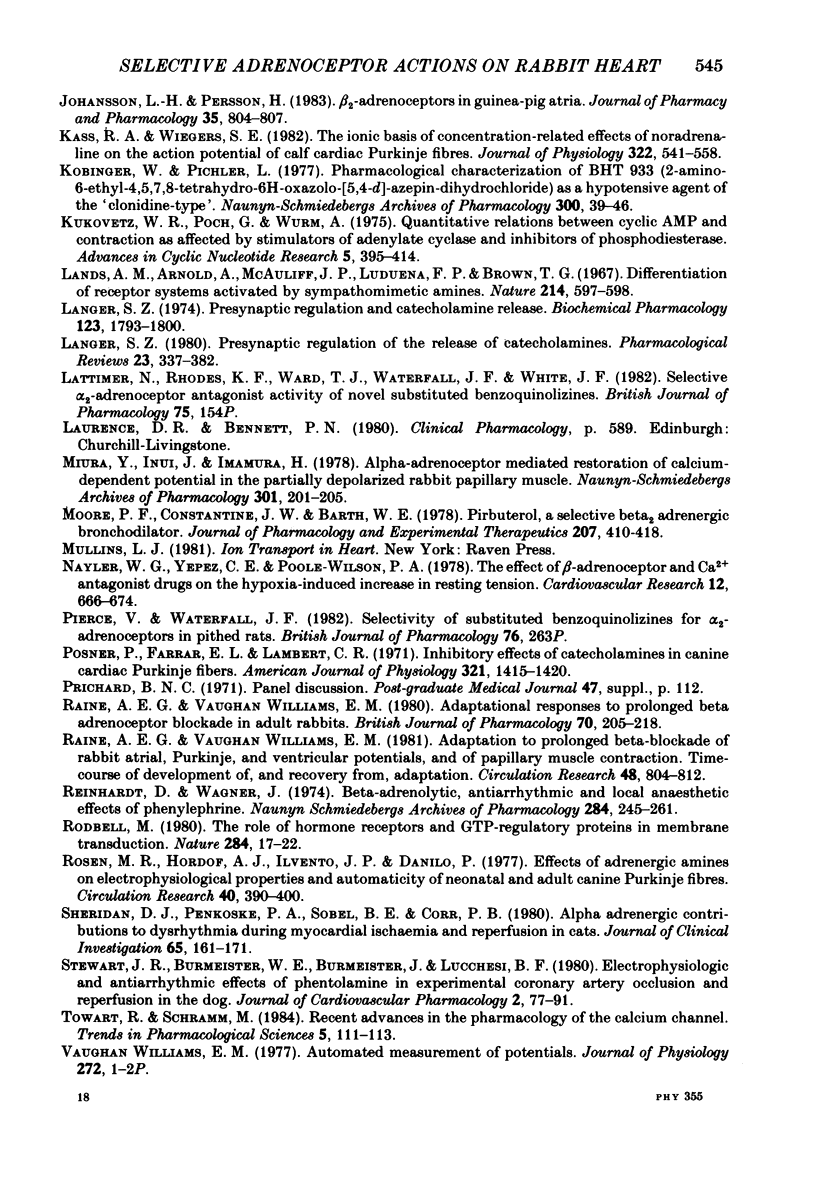
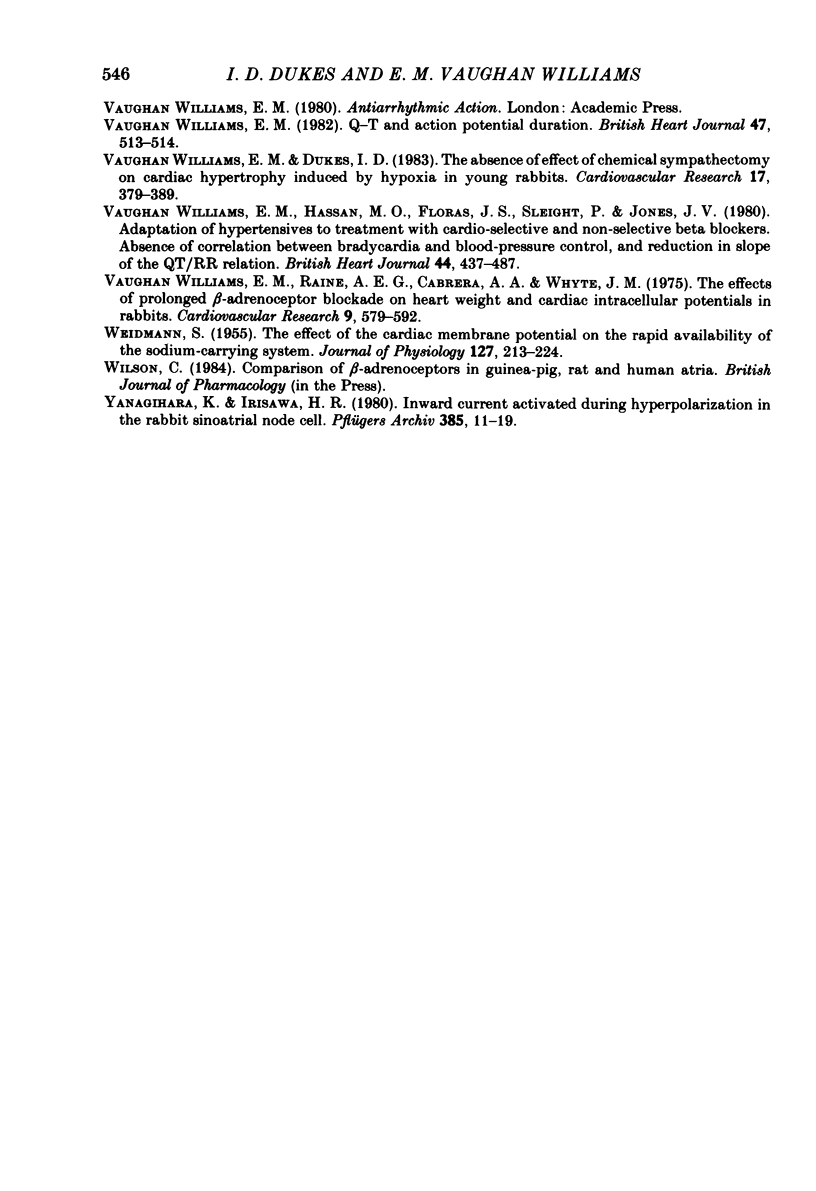
Selected References
These references are in PubMed. This may not be the complete list of references from this article.
- Arnold L., Page J., Attwell D., Cannell M., Eisner D. A. The dependence on heart rate of the human ventricular action potential duration. Cardiovasc Res. 1982 Oct;16(10):547–551. doi: 10.1093/cvr/16.10.547. [DOI] [PubMed] [Google Scholar]
- BLINKS J. R. THE NATURE OF THE ANTAGONISM BY METHOXAMINE OF THE CHRONOTROPIC AND INOTROPIC EFFECTS OF CATECHOLAMINES. Naunyn Schmiedebergs Arch Exp Pathol Pharmakol. 1964 Apr 21;248:73–84. doi: 10.1007/BF00247060. [DOI] [PubMed] [Google Scholar]
- Bilski A. J., Halliday S. E., Fitzgerald J. D., Wale J. L. The pharmacology of a beta 2-selective adrenoceptor antagonist (ICI 118,551). J Cardiovasc Pharmacol. 1983 May-Jun;5(3):430–437. doi: 10.1097/00005344-198305000-00013. [DOI] [PubMed] [Google Scholar]
- Birkhead J. S., Vaughan Williams E. M., Gwilt D. J., Tanqueray A., Cazes C. Heart rate and QT interval in subjects adapted to beta-blockade: bradycardia and hypotension as uncorrelated adaptations. Cardiovasc Res. 1983 Nov;17(11):649–655. doi: 10.1093/cvr/17.11.649. [DOI] [PubMed] [Google Scholar]
- Brodde O. E., Leifert F. J., Krehl H. J. Coexistence of beta 1- and beta 2-adrenoceptors in the rabbit heart: quantitative analysis of the regional distribution by (-)-3H-dihydroalprenolol binding. J Cardiovasc Pharmacol. 1982 Jan-Feb;4(1):34–43. doi: 10.1097/00005344-198201000-00007. [DOI] [PubMed] [Google Scholar]
- Brodde O. E., Motomura S., Endoh M., Schümann H. J. Lack of correlation between the positive inotropic effect evoked by alpha-adrenoceptor stimulation and the levels of cyclic AMP and/or cyclic GMP in the isolated ventricle strip of the rabbit. J Mol Cell Cardiol. 1978 Mar;10(3):207–219. doi: 10.1016/0022-2828(78)90344-9. [DOI] [PubMed] [Google Scholar]
- Brown H. F., DiFrancesco D., Noble S. J. How does adrenaline accelerate the heart? Nature. 1979 Jul 19;280(5719):235–236. doi: 10.1038/280235a0. [DOI] [PubMed] [Google Scholar]
- Bryan L. J., Cole J. J., O'Donnell S. R., Wanstall J. C. A study designed to explore the hypothesis that beta-1 adrenoceptors are "innervated" receptors and beta-2 adrenoceptors are "hormonal" receptors. J Pharmacol Exp Ther. 1981 Feb;216(2):395–400. [PubMed] [Google Scholar]
- Cooke N. J., Kerr J. A., Willey R. F., Hoare M. V., Grant I. W., Cromptom G. K. Response to rimiterol and salbutamol aerosols administered by intermittent positive-pressure ventilation. Br Med J. 1974 May 4;2(5913):250–252. doi: 10.1136/bmj.2.5913.250. [DOI] [PMC free article] [PubMed] [Google Scholar]
- Corr P. B., Shayman J. A., Kramer J. B., Kipnis R. J. Increased alpha-adrenergic receptors in ischemic cat myocardium. A potential mediator of electrophysiological derangements. J Clin Invest. 1981 Apr;67(4):1232–1236. doi: 10.1172/JCI110139. [DOI] [PMC free article] [PubMed] [Google Scholar]
- Costin B. I., O'Donnell S. R., Wanstall J. C. Chronotropic responses of rabbit isolated atria to beta-adrenoceptor agonists are mediated by only beta 1-adrenoceptors. J Pharm Pharmacol. 1983 Nov;35(11):752–754. doi: 10.1111/j.2042-7158.1983.tb02886.x. [DOI] [PubMed] [Google Scholar]
- Gadsby D. C. Beta-adrenoceptor agonists increase membrane K+ conductance in cardiac Purkinje fibres. Nature. 1983 Dec 15;306(5944):691–693. doi: 10.1038/306691a0. [DOI] [PubMed] [Google Scholar]
- Giotti A., Ledda F., Mannaioni P. F. Effects of noradrenaline and isoprenaline, in combination with - and -receptor blocking substances, on the action potential of cardiac Purkinje fibres. J Physiol. 1973 Feb;229(1):99–113. doi: 10.1113/jphysiol.1973.sp010129. [DOI] [PMC free article] [PubMed] [Google Scholar]
- Govier W. C., Mosal N. C., Whittington P., Broom A. H. Myocardial alpha and beta adrenergic receptors as demonstrated by atrial functional refractory-period changes. J Pharmacol Exp Ther. 1966 Nov;154(2):255–263. [PubMed] [Google Scholar]
- Govier W. C. Myocardial alpha adrenergic receptors and their role in the production of a positive inotropic effect by sympathomimetic agents. J Pharmacol Exp Ther. 1968 Jan;159(1):82–90. [PubMed] [Google Scholar]
- Hauswirth O., Noble D., Tsien R. W. Adrenaline: mechanism of action on the pacemaker potential in cardiac Purkinje fibers. Science. 1968 Nov 22;162(3856):916–917. doi: 10.1126/science.162.3856.916. [DOI] [PubMed] [Google Scholar]
- Hedberg A., Mattsson H. Beta adrenoceptor interaction of full and partial agonists in the cat heart and soleus muscle. J Pharmacol Exp Ther. 1981 Dec;219(3):798–808. [PubMed] [Google Scholar]
- Heitz A., Schwartz J., Velly J. Beta-adrenoceptors of the human myocardium: determination of beta 1 and beta 2 subtypes by radioligand binding. Br J Pharmacol. 1983 Dec;80(4):711–717. doi: 10.1111/j.1476-5381.1983.tb10062.x. [DOI] [PMC free article] [PubMed] [Google Scholar]
- Imaizumi Y., Watanabe M. The effect of tetraethylammonium chloride on potassium permeability in the smooth muscle cell membrane of canine trachea. J Physiol. 1981 Jul;316:33–46. doi: 10.1113/jphysiol.1981.sp013770. [DOI] [PMC free article] [PubMed] [Google Scholar]
- Innemee H. C., de Jonge A., van Meel J. C., Timmermans P. B., van Zwieten P. A. The effect of selective alpha 1- and alpha 2-adrenoceptor stimulation on intraocular pressure in the conscious rabbit. Naunyn Schmiedebergs Arch Pharmacol. 1981 Jul;316(4):294–298. doi: 10.1007/BF00501360. [DOI] [PubMed] [Google Scholar]
- Isenberg G. Cardiac Purkinje fibres: [Ca2+]i controls the potassium permeability via the conductance components gK1 and gK2. Pflugers Arch. 1977 Oct 19;371(1-2):77–85. doi: 10.1007/BF00580775. [DOI] [PubMed] [Google Scholar]
- Johansson L. H., Persson H. Beta 2-adrenoceptors in guinea-pig atria. J Pharm Pharmacol. 1983 Dec;35(12):804–807. doi: 10.1111/j.2042-7158.1983.tb02900.x. [DOI] [PubMed] [Google Scholar]
- Kass R. S., Wiegers S. E. The ionic basis of concentration-related effects of noradrenaline on the action potential of calf cardiac purkinje fibres. J Physiol. 1982 Jan;322:541–558. doi: 10.1113/jphysiol.1982.sp014054. [DOI] [PMC free article] [PubMed] [Google Scholar]
- Kobinger W., Pichler L. Pharmacological characterization of B-HT 933 (2-amino-6-ethyl-4,5,7,8,-tetrahydro-6H-oxazolo-[5,4-d]-azepindihydrochloride) as a hypotensive agent of the "clonidine-type". Naunyn Schmiedebergs Arch Pharmacol. 1977 Oct;300(1):39–46. doi: 10.1007/BF00505078. [DOI] [PubMed] [Google Scholar]
- Kukovetz W. R., Pöch G., Wurm A. Quantitative relations between cyclic AMP and contraction as affected by stimulators of adenylate cyclase and inhibitors of phosphodiesterase. Adv Cyclic Nucleotide Res. 1975;5:395–414. [PubMed] [Google Scholar]
- Lands A. M., Arnold A., McAuliff J. P., Luduena F. P., Brown T. G., Jr Differentiation of receptor systems activated by sympathomimetic amines. Nature. 1967 May 6;214(5088):597–598. doi: 10.1038/214597a0. [DOI] [PubMed] [Google Scholar]
- Langer S. Z. Presynaptic regulation of catecholamine release. Biochem Pharmacol. 1974 Jul 1;23(13):1793–1800. doi: 10.1016/0006-2952(74)90187-7. [DOI] [PubMed] [Google Scholar]
- Langer S. Z. Presynaptic regulation of the release of catecholamines. Pharmacol Rev. 1980 Dec;32(4):337–362. [PubMed] [Google Scholar]
- Miura Y., Inui J., Imamura H. Alpha-adrenoceptor-mediated restoration of calcium-dependent potential in the partially depolarized rabbit papillary muscle. Naunyn Schmiedebergs Arch Pharmacol. 1978 Jan-Feb;301(3):201–205. doi: 10.1007/BF00507038. [DOI] [PubMed] [Google Scholar]
- Moore P. F., Constantine J. W., Barth W. E. Pirbuterol, a selecttve beta2 adrenergic bronchodilator. J Pharmacol Exp Ther. 1978 Nov;207(2):410–418. [PubMed] [Google Scholar]
- Nayler W. G., Yepez C. E., Poole-Wilson P. A. The effect of beta-adrenoceptor and Ca2+ antagonist drugs on the hypoxia-induced increased in resting tension. Cardiovasc Res. 1978 Nov;12(11):666–674. doi: 10.1093/cvr/12.11.666. [DOI] [PubMed] [Google Scholar]
- Raine A. E., Vaughan Williams E. M. Adaptation to prolonged beta-blockade of rabbit atrial, purkinje, and ventricular potentials, and of papillary muscle contraction. Time-course of development of and recovery from adaptation. Circ Res. 1981 Jun;48(6 Pt 1):804–812. doi: 10.1161/01.res.48.6.804. [DOI] [PubMed] [Google Scholar]
- Raine A. E., Vaughan Williams E. M. Adaptational responses to prolonged beta-adrenoceptor blockade in adult rabbits. Br J Pharmacol. 1980 Oct;70(2):205–218. doi: 10.1111/j.1476-5381.1980.tb07926.x. [DOI] [PMC free article] [PubMed] [Google Scholar]
- Reinhardt D., Wagner J. Beta-adrenolytic, antiarrhythmic and local anaesthetic effects of phenylephrine. Naunyn Schmiedebergs Arch Pharmacol. 1974;284(3):245–261. doi: 10.1007/BF00500345. [DOI] [PubMed] [Google Scholar]
- Rodbell M. The role of hormone receptors and GTP-regulatory proteins in membrane transduction. Nature. 1980 Mar 6;284(5751):17–22. doi: 10.1038/284017a0. [DOI] [PubMed] [Google Scholar]
- Rosen M. R., Hordof A. J., Ilvento J. P., Danilo P., Jr Effects of adrenergic amines on electrophysiological properties and automaticity of neonatal and adult canine Purkinje fibers: evidence for alpha- and beta-adrenergic actions. Circ Res. 1977 Apr;40(4):390–400. doi: 10.1161/01.res.40.4.390. [DOI] [PubMed] [Google Scholar]
- Sheridan D. J., Penkoske P. A., Sobel B. E., Corr P. B. Alpha adrenergic contributions to dysrhythmia during myocardial ischemia and reperfusion in cats. J Clin Invest. 1980 Jan;65(1):161–171. doi: 10.1172/JCI109647. [DOI] [PMC free article] [PubMed] [Google Scholar]
- Stewart J. R., Burmeister W. E., Burmeister J., Lucchesi B. R. Electrophysiologic and antiarrhythmic effects of phentolamine in experimental coronary artery occlusion and reperfusion in the dog. J Cardiovasc Pharmacol. 1980 Jan-Feb;2(1):77–91. doi: 10.1097/00005344-198001000-00009. [DOI] [PubMed] [Google Scholar]
- Vaughan Williams E. M. QT and action potential duration. Br Heart J. 1982 Jun;47(6):513–514. doi: 10.1136/hrt.47.6.513. [DOI] [PMC free article] [PubMed] [Google Scholar]
- WEIDMANN S. The effect of the cardiac membrane potential on the rapid availability of the sodium-carrying system. J Physiol. 1955 Jan 28;127(1):213–224. doi: 10.1113/jphysiol.1955.sp005250. [DOI] [PMC free article] [PubMed] [Google Scholar]
- Williams E. M., Dukes I. D. The absence of effect of chemical sympathectomy on ventricular hypertrophy induced by hypoxia in young rabbits. Cardiovasc Res. 1983 Jul;17(7):379–389. doi: 10.1093/cvr/17.7.379. [DOI] [PubMed] [Google Scholar]
- Williams E. M., Hassan M. O., Floras J. S., Sleight P., Jones J. V. Adaptation of hypertensives to treatment with cardioselective and non-selective beta-blockers. Absence of correlation between bradycardia and blood pressure control, and reduction in slope of the QT/RR relation. Br Heart J. 1980 Nov;44(5):473–487. doi: 10.1136/hrt.44.5.473. [DOI] [PMC free article] [PubMed] [Google Scholar]
- Williams E. M., Raine A. E., Cabrera A. A., Whyte J. M. The effects of prolonged beta-adrenoceptor blockade on heart weight and cardiac intracellular potentials in rabbits. Cardiovasc Res. 1975 Sep;9(5):579–592. doi: 10.1093/cvr/9.5.579. [DOI] [PubMed] [Google Scholar]
- Yanagihara K., Irisawa H. Inward current activated during hyperpolarization in the rabbit sinoatrial node cell. Pflugers Arch. 1980 May;385(1):11–19. doi: 10.1007/BF00583909. [DOI] [PubMed] [Google Scholar]


